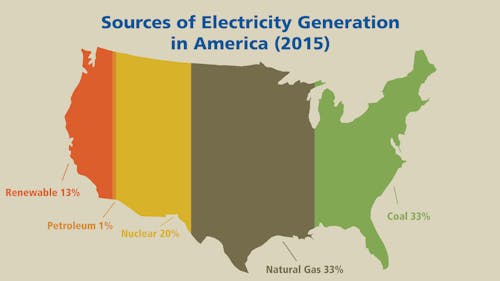Tech Tuesday: How do we get our power?

On Wednesday, Sept. 14, the Cook and Douglass campuses faced power outages that led to all 3,200 residents being relocated for the night.
It was later explained that these 36 hours of blackouts were not caused by the power supplier, PSE&G, but by Rutgers and a malfunctioning piece of equipment.
To get electricity to campus, power moves through a grid. The entire US “power grid” is divided into three large systems. These systems divide the country in half through the Rocky Mountains, and north and south through Texas.
The power grid is composed of more than 7,300 power plants, millions of miles of power lines and transformers. It was originally divided into three main regions to ensure that everyone had access to electricity.
At its most basic level, electricity is essentially the movement of electrons between atoms. This happens when electrons further away from an atom’s nucleus are pushed out, going into motion and forming electricity.
Examples of electricity in nature include lightning strikes, where electrons move from clouds to the ground, and rubbing a balloon on someone’s head, where electrons move from the balloon to the person’s hair, according to the site.
In the 1830s, Michael Faraday discovered that moving a magnet inside a metal wire coil leads creates an electric current in the coil.
This happens similarly to how magnets repel each other. Moving the magnet inside a coil pushes the electrons in the metal, putting them into motion and creating a current.
By applying this on a larger scale, generators are able to create large amounts of electricity. A magnet formed from electricity is placed inside a series of coils and put into motion. Currents are formed in each coil, which are later combined and sent to the consumer.
To put the magnet into motion, some sort of drive is needed. This typically comes in the form of a turbine that can be powered from a variety of sources, from natural gas to nuclear energy, according to the site.
One way to power generators is by burning fossil fuels, such as coal and oil, to create steam that power turbines. Although it is reliable, the process creates carbon dioxide and other pollutants.
Another method is the use of hydropower plants, which use dams to store water and later let it flow through to power the turbine. Despite the water eventually returning to its river, flooding behind the dam and slowing the river can have negative ecological effects, according to the site.
Nuclear power plants work similarly to fossil fuel plants by generating steam to drive turbines. This process does not produce greenhouse gasses, but does create waste that can be reused for more energy production, according to the World Nuclear Organization.
Despite these benefits, waste produced in nuclear power plants can pose a threat to the environment in the event of an accident. Further, although it does not produce carbon dioxide, the processes to mine and manage waste does.
These power plants use nuclear fission, a process where large, unstable atom is hit with high-speed particles. The large atom, typically Uranium-235, then breaks into smaller pieces, releasing high amounts of energy, according to the website for the Nuclear Information Center at Duke Energy.
Renewable energy can also be used to power turbines. The use of wind and solar energy creates little to no greenhouses gasses but do not provide reliable energy because they rely on natural factors like sunshine and wind speed, according to the World Nuclear Association.
The cost of renewable energy is also presently higher than other energy sources but is decreasing. Fossil fuel prices rely on the available supply, influencing the price consumer pay, according to the site.
Most of the energy in the U.S. is generated by using steam turbines powered by fossil fuels. Twenty percent of U.S. energy is produced by nuclear energy, and about 13 percent is produced by renewable energy.
Once electricity is produced by a generator, thick wires carry it to a transformer that increases, its voltage tremendously before sending it out to the power grid.
High-voltage transmission lines then carry this current out through the power grid, reaching substations along the way that decrease, the voltage to a level that may be used by large consumers like factories, the site reads.
The grid is divided into three main groups, the Western Interconnection, the Eastern Interconnection and the Texas Interconnection so that all power utilities could share resources and increase reliability while decreasing costs.
Distribution lines carry power from the substations to small, local transformers, which eventually reduce the voltage so it can be safely used by the average person, according to GE.
Finally, a meter in the consumer’s home or business measures the energy sent to it and distributes that energy through the wires and outlets it is connected to. The circuit from the power plant is complete when the consumer uses the power, according to the site.
Similar to how the U.S. divided into three main power grids, each campus in Rutgers-New Brunswick has its own grid, so the power outage on the Cook/Douglass campus would not affect Busch, Livingston or College Avenue. The outage was due to a malfunctioning transformer.
Harshel Patel is a School of Arts and Sciences sophomore majoring in molecular biology and biochemistry. He is the digital editor of The Daily Targum. He can be found on Twitter @harshel_p.



